Are You Ready for a Life Cycle Approach for Analytical Instruments and Systems?
The calibration and qualification of analytical systems is a journey, not an event.
The need to calibrate and qualify analytical instruments and systems is well recognized in laboratories. However, calibrating and qualifying analytical instruments and systems are seen as discrete tasks. There is an increasing regulatory expectation that a risk-based life cycle approach is necessary to ensure “fitness for purpose” as part of an analytical procedure. The calibration and qualification lifecycle of analytical instruments and systems is a journey and not a sequence of disconnected events.
This article describes the principal stages of the lifecycle in both GXP or ISO/IEC 17025 laboratories that ensure that any analytical instrument and system is “fit for its intended use” as part of an analytical procedure, whether that is calibration or qualification. However, the tasks typically associated with these stages are often seen as discrete activities, but they should be integrated to form a continuum. In other words, the calibration and qualification lifecycle of analytical instruments and systems is a continuous journey, not a sequence of disconnected events. It is timely to consider a lifecycle approach because the United States Pharmacopoeia (USP) proposed a new General Chapter <1220> in September 2020 for analytical procedure lifecycle management (APLM) (1). There are no novel elements in this approach, but there is a structured process linking these activities that is described here.
Begin at the Beginning
Our starting point is the U.S. Good Manufacturing Practice (GMP) regulation for equipment design, size, and location in 21 CFR 211.63 that states briefly:
Equipment used in the manufacture, processing, packing, or holding of a drug product shall be of appropriate design, adequate size, and suitably located to facilitate operations for its intended use and for its cleaning and maintenance (2,3).
What does the phrase “intended use” mean and how should “fitness for intended use or purpose” be demonstrated in a regulated laboratory? Using our analytical instruments for analysis, we reviewed the high level process flow for the analytical procedure lifecycle from the proposed USP <1220> shown in Figure 1 (1). Notice that the key part of the process is stage 1 (Procedure Design, Development and Understanding). Method development is critical to the success of the whole process, and the draft USP <1220> covers an activity that the current International Council on Harmonization (ICH) Q2(R1) does not (4). Consequently, analysts developing methods must ensure that their analytical instruments are qualified and calibrated correctly and that the analytical systems are validated to ensure the smooth development and transfer of methods to the next stage of the lifecycle, which is called procedure performance qualification (PPQ). Qualification and calibration of analytical instruments is particularly important when analytical procedures are developed and validated in Research and Development (R&D) and later transferred to quality control laboratories.
Figure 1 shows that analytical procedure validation is no longer a discrete activity but a journey. As part of that journey, the first aspect of stage 2 PPQ requires qualification and calibration of instruments and systems as a prerequisite.
FIGURE 1: High level model for the analytical procedure lifecycle.
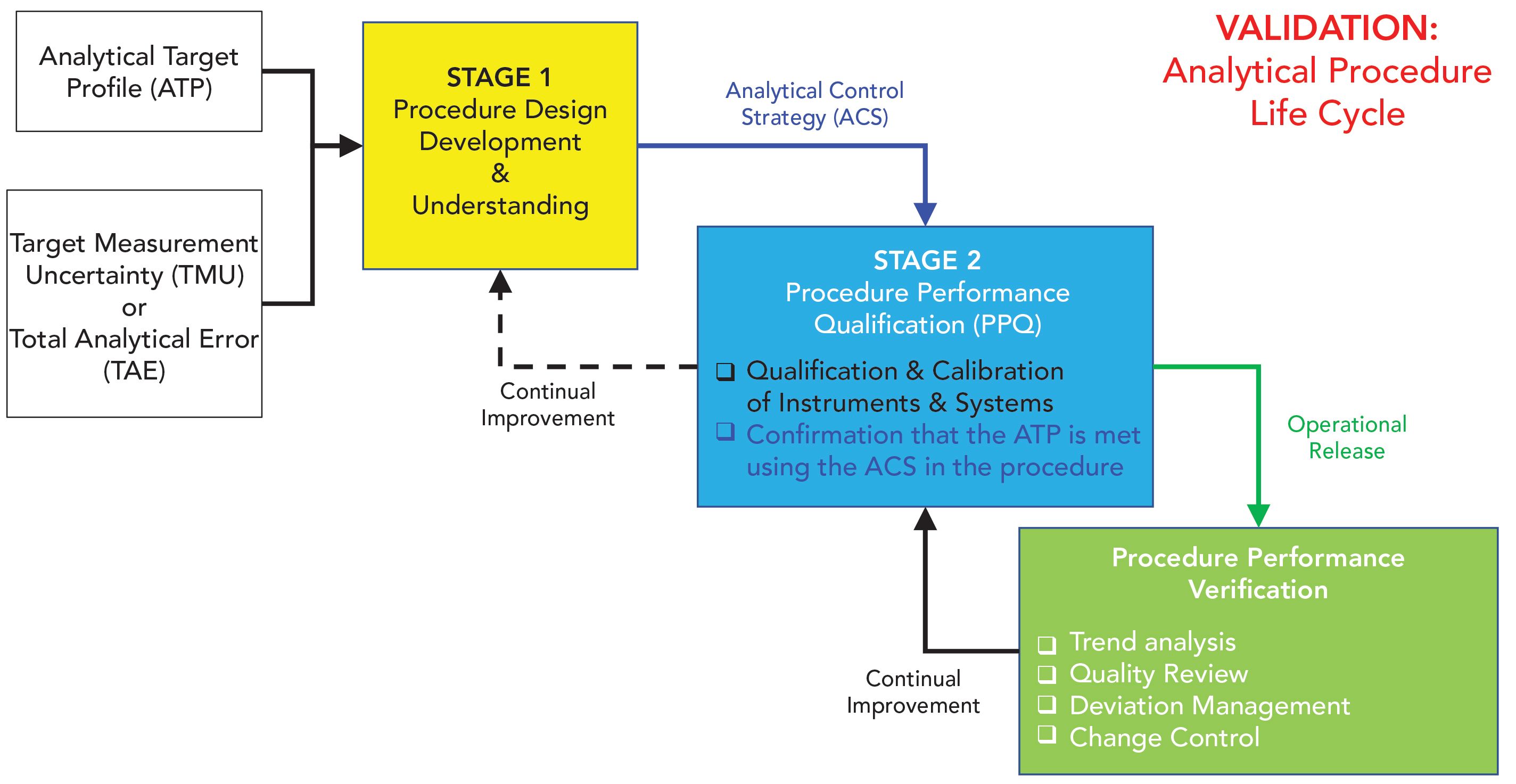
Analytical Process: Where Does Qualification and Calibration Fit?
The analytical process, conducted within a pharmaceutical quality management system, provides reliable, traceable, and reportable values that are secure. The basic analytical process is shown in Figure 2 together with the relationship to stage 2 of the APLM highlighted in blue.
FIGURE 2: Overview of the basic analytical process.
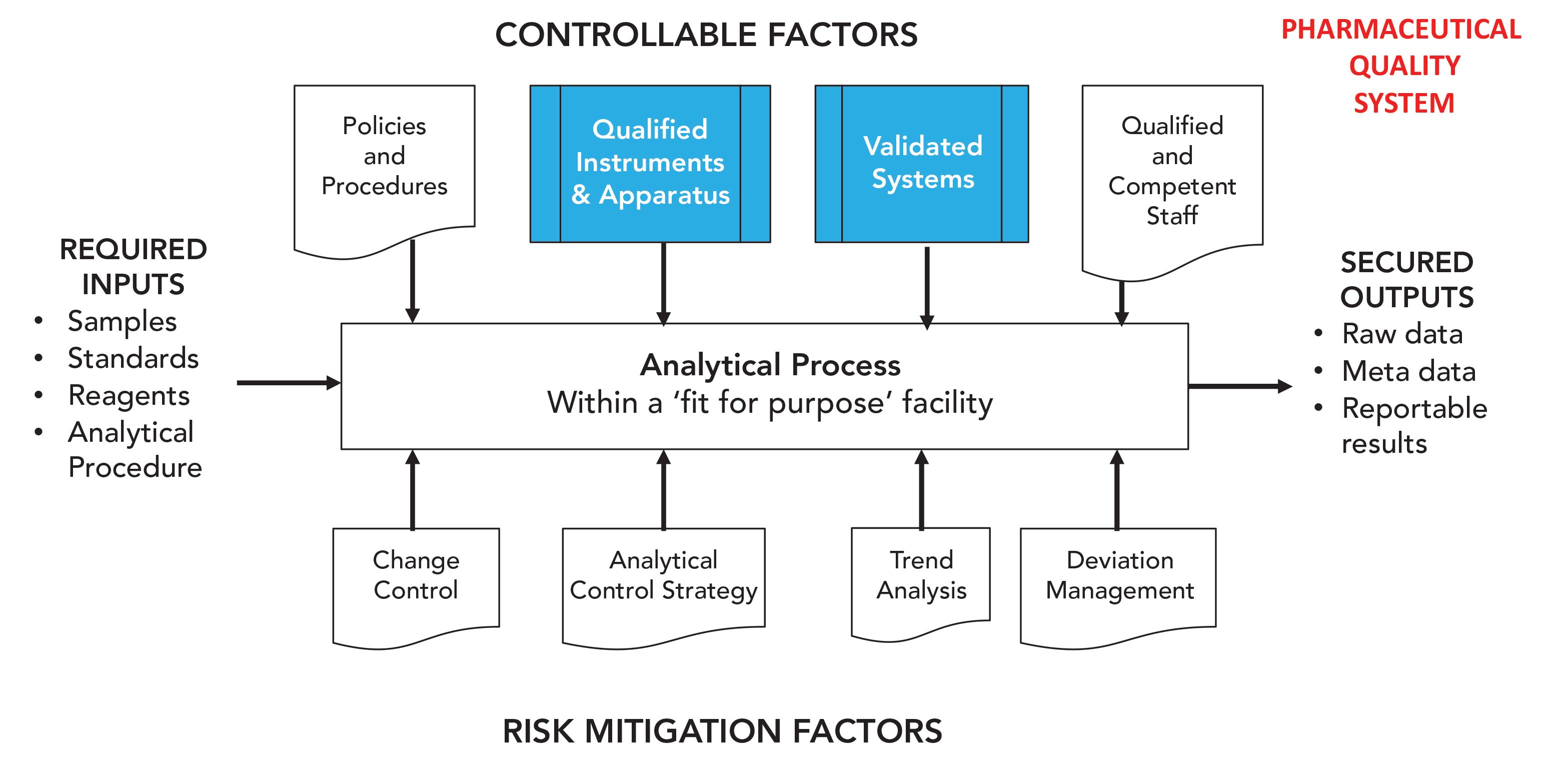
If we cannot demonstrate “fitness for purpose” of our instruments and systems, then outputs from our analytical process are unreliable. The current regulatory focus on data integrity and data governance requires us to put in place technical and procedure controls throughout the analytical process to ensure that data and records are trustworthy and reliable, and that quality decisions can be made in confidence.
The data governance and data integrity requirements and controls for a proposed analytical instrument and system (AIS) lifecycle that is defensible from a regulatory and technical perspective in Figure 2 can be mapped to the Foundation and Level 1 of a Data Integrity Model (5-8), shown in Figure S1, online. The Foundation ensures the right culture, ethos, and training for data governance and Level 1 ensures that instruments and computerized systems are calibrated, qualified and where appropriate validated for their intended use.
Analytical Instrument and System Lifecycle
The overall purpose of the AIS lifecycle is to demonstrate that not only is the instrument or system calibrated or qualified, but that any software is suitably validated and is operating in a controlled state. It is only then may we claim that the instrument or system is “fit for intended purpose” so that metrological data integrity is ensured. This article focuses on level 1 in this model concerning metrological integrity. The AIS lifecycle is shown in Figure 3. Data quality is only ensured if all components of data integrity and data governance are in place.
FIGURE 3: Proposed analytical instruments and systems (AIS) lifecycle.
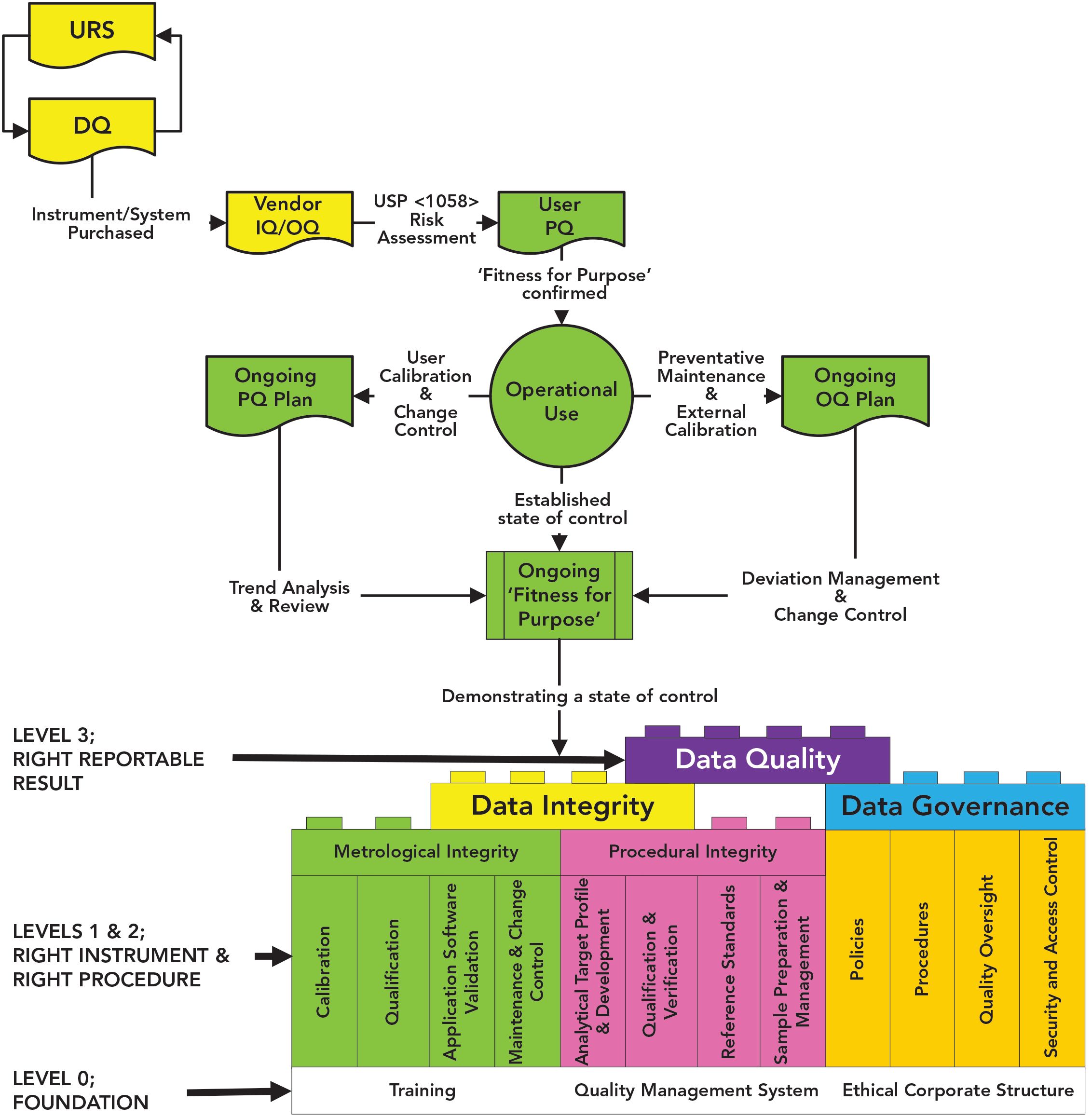
The levels of the AIS, with a specific focus on analytical instruments and systems, are presented at the bottom of Figure 3. Levels 1 and 2 are broken down into four elements each to provide metrological and procedural integrity, respectively. Levels 1 and 2 also overlay the culture and ethos of the foundation level. The quality oversight and some of the foundation level elements of the model are combined under data governance. Together these provide the essential requirements for the right reportable result at level 3 with associated data quality to ensure the correct decision is made.
The top portion of Figure 3 is based on the requirements of USP <1058>, analytical instrument qualification (9)that requires the following:
1) A laboratory user requirements specification (URS) to select the right instrument for the job (design qualification)
2) Following purchase of the instrument, a supplier IQ/OQ is per- formed to demonstrate that the requirements in the laboratory URS have been met. If this is not the case, the laboratory needs to conduct supplementary qualification tests to match the operating ranges specified.
3) Performance qualification (PQ) tests to demonstrate that the laboratory specifications are being met during operation of the instrument must be devised along with a plan for requalification of the instrument both after repair and maintenance but also periodically.
4) The PQ test performance should be trended to detect any changes as well as maintaining deviation management and change control to demonstrate that the instrument is in a state of control.
The authors have published a risk assessment to help classify analytical instruments and systems into the USP <1058> groups and subtypes and suggest the extent of computerized system validation to be undertaken (10). Combining all the activities shown in Figure 3 ensures that analytical instruments and systems generate data and reportable results with appropriate integrity and quality.
Recently in Pharmacopoeial Forum, a stimulus to the revision process article was published discussing a lifecycle approach to both calibration and qualification (11). However, before we discuss this article, we need to consider the applicable FDA GMP regulations, by going back to the future.
What Do We Mean By...?
Since the promulgation of the GMP regulations in 1978, approaches to ensuring that analytical instruments are “fit for intended use” have changed along with the terminology. Analytical instruments have changed and software, either in the form of firmware or a separate data system, now comprises a major component of modern analytical instrumentation. However, the wording of the regulations has not changed but the interpretation of them has. In 21 CFR 211.160(b) there are requirements that any laboratory control mechanisms must be scientifically sound and in 211.160(b)(4) we have the following requirement for calibration (3):
The calibration of instruments, apparatus, gauges, and recording devices at suitable intervals in accordance with an established written program containing specific directions, schedules, limits for accuracy and precision, and provisions for remedial action in the event accuracy and/or precision limits are not met. Instruments, apparatus, gauges, and recording devices not meeting established specifications shall not be used.
The records for such calibrations are defined in 211.194 (d) (3):
Complete records shall be maintained of the periodic calibration of laboratory instruments, apparatus, gauges, and recording devices required by 211.160(b)(4).
The problem is that the U.S. GMP regulations only mention calibration and therefore citations in 483 observations and warning letters will only cite deficiencies in instrument calibration when a qualification lapse could be the cause of the noncompliance, resulting in potential confusion. However, as our understanding of how to demonstrate fitness for intended use has evolved, so has the terminology.
Wider Scope and More Definitions
The terms used within this section are one of the sources of great confusion between laboratories. For example, calibration can sometimes be used as a general “descriptive label” or have a specific meaning within the context of use. In addition to calibration, we now have the terms qualification, validation, and verification also in common use. USP general chapter <1058> on analytical instrument qualification (9) provides an integrated approach to qualification of the analytical instrument and validation of the software. This general chapter mentions the terms calibration, qualification, verification, and validation. What do these terms mean? Are they linked? And where are we going in the future? All organizations, including regulatory authorities, need a technical glossary. There is no technical glossary that ensures a consistent meaning and use of terms throughout the pharmacopeia and other regulatory documents.
Calibration
It is generally accepted that calibration forms part of the overall qualification process of an instrument or system. Calibration is all about metrology. Calibration is that part of qualification relating to measurement integrity of the ordinate response and abscissa functions, that is, all measurements from the instrument or system are within defined acceptance limits of a true or certified value.
The foundation for assurance of metrological “fitness for purpose” lies with the correct use of either a certified reference material (CRM) or a reference standard (RS). In the pharmacopeia, calibration is a comparison between a known or accepted value of a CRM or RS with its measured value on a specific laboratory analytical instrument or system being used for a pharmacopeial purpose the difference between these two values is compared with an acceptance criterion that may be an acceptable range or tolerance interval. For example, the measured value of a certified standard value of a wavelength standard must lie within the acceptance criteria of ±2 nm over the spectral range 200 to 400 nm. For some analytical instruments, calibration may all that is required (9).
Qualification
Qualification is about overall “fitness for purpose” of an instrument or system, not only about good numbers. Hence the pharmacopeias require qualified instruments and systems. USP <1058> is the only pharmacopoeial general chapter to describe the overall process of analytical instrument qualification (9).
Verification
Currently, verification in the USP relates to the “fitness for purpose” of analytical procedures as required by the General Chapter on Verification of Analytical Procedures <1226> (12). However, verification is also used in the American National Standards Institute (ANSI) for software to refer to demonstrating that each individual step is mathematically or procedurally correct. GAMP 5 describes the testing phases of a computerized system lifecycle to demonstrate meeting user specifications (13). Therefore, some aspects of modular calibration (see later section) may be regarded as a verification process. The current version of USP <1058> on analytical instrument qualification (AIQ) does not use verification in either senses described under.
Validation
Currently, validation relates either to the establishment of analytical procedures as required by General Chapter <1225>, Validation of Analytical Procedures (14) or particularly in General Chapter <1058>, Analytical Instrument Qualification for “fitness for purpose” (9). For example, in the “Instrument Control, Acquisition and Processing Software” section of <1058>, it states:
At the user site, integrated qualification of the instrument, in conjunction with validation of the software, involves the entire system. This is more efficient than separating instrument qualification from validation of the software (9).
However, there is a diversity of definitions for calibration, qualification, verification, and validation within the USP General Chapters that need to be harmonized to assist understanding and prevent user confusion. This is particularly true for the differentiation of holistic and modular calibration standards and the expression of acceptance criteria for establishing “fitness for purpose” (15,16).
Calibration and Qualification Lifecycle
The perennial question of “who does what and when” is answered in the lifecycle approach to calibration shown in Figure 4. The solid lines denote the primary process flows for establishing and confirming “fitness for purpose.” Dotted or dashed lines indicate either feedback loops triggered by data generated during the ongoing performance phase or, in the case of the URS, supported by the vendor.
FIGURE 4: Generic process of calibration and qualification should be designed to allow confirmation of lifecycle “fitness for purpose.”
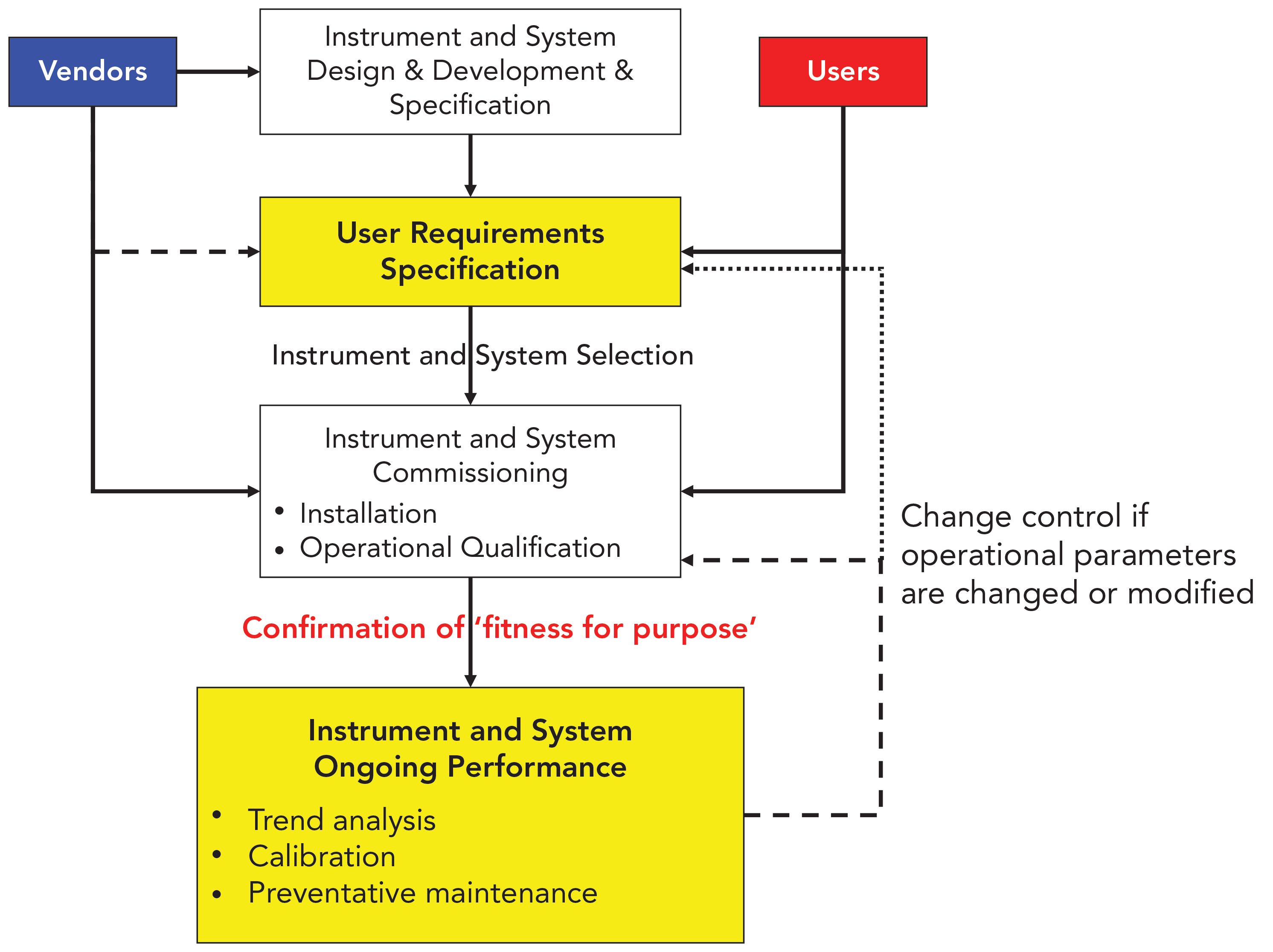
The generic process of calibration and qualification should be designed to allow confirmation of “fitness for purpose” at all stages in the lifecycle including assurance of preventative maintenance and change control.
Users need to define their own control strategy to specify ongoing “fitness for purpose” by establishing the frequency of calibration, standards and acceptance criteria that will be employed and trend analysis of the ongoing performance data from the instrument.
One important aspect of the calibration and qualification lifecycle is the presence of change control feedback loops as part of the lifecycle. For example, if the qualified operational wavelength range for a UV spectrometer was originally 240 to 600 nm and the requirement is to extend this to 210 to 600 nm, then a new qualification standard is required to confirm “fitness for purpose” (17–19). In addition, the laboratory URS needs to be reviewed to ensure that the instrument was correctly specified originally to allow the revision of operational range.
Do You Specify Exactly What You Need the Instrument or System to Do?
The key requirement from 21 CFR 211.63, 21 CFR 211.160(b) (3) and USP <1058> (9) is defined in a user specification. These are laboratory requirements for any analytical instrument with scientifically sound acceptance criteria. This does not mean simply copying the supplier’s specification, as discussed in an earlier column (18) but defining what is actually required. For example, if a UV-vis spectrometer has a supplier’s wavelength specification between 190 and 800 nm, what do you actually use? For example, if you only require measurement between 210 and 300 nm, then this should be your operating range. The requirement for wavelength accuracy is contained in USP <857> (20) and this should be quoted in the specification document for the instrument. Testing wavelength accuracy using a CRM (for example, a holmium perchlorate solution or a glass filter) should demonstrate that this user requirement is met and that the instrument performs within scientifically sound acceptance criteria. Similar approaches need to be undertaken for the other technical requirements for the spectrometer.
Best Practices for Instrument Calibration
The best practice is to use the most stable artifact with the smallest uncertainty budget. For example, for routine monitoring of UV-vis and near infrared spectrometers, solid or liquid filters traceable to a national measurement institution (NMI), for both wavelength and absorbance accuracy qualification provide the most reliable option for the user.
For example, Figure 5 shows an overview of available standards for UV-vis-NIR over the overall spectral range available from one manufacturer. For example, to cover an operational wavelength range of 200 to 795 nm, two references would be required.
FIGURE 5: Traceable CRMs for the UV-vis-NIR spectral range of 190 nm to 2850 nm (21).
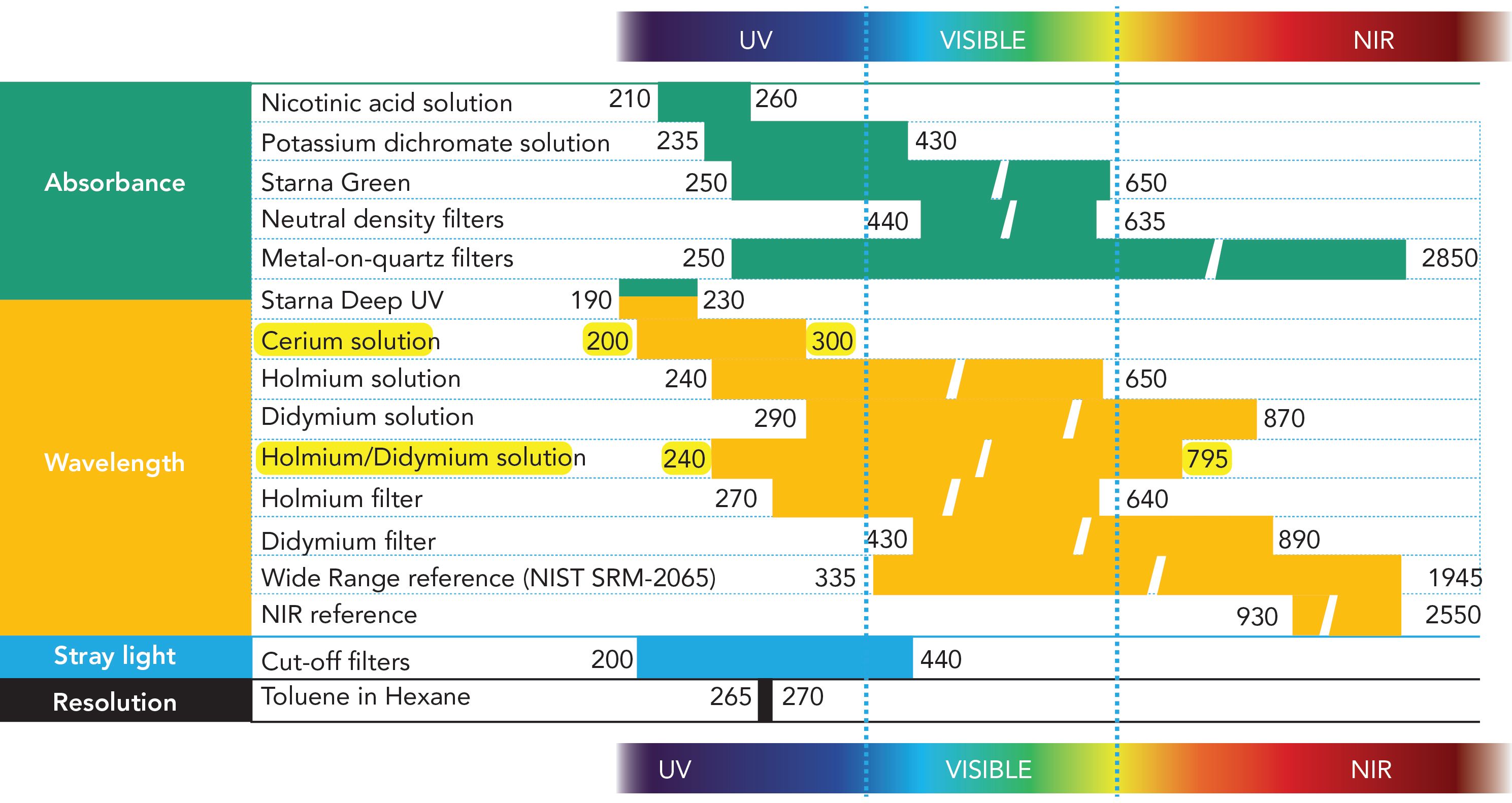
However, this is not always an option if the appropriate traceable standards are either non-existent or not readily available. For example, USP <855> on nephelometry and turbidimetry functional or holistic standards are not currently available as traceable standards, and the user is reliant on the manual preparation method, which is both difficult and time consuming.
Is Calibration Equivalent to Qualification?
For some analytical instruments, calibration is potentially all that is required to ensure fitness for purpose. Typically, these are USP <1058> Group B instruments such as analytical balances and pH meters where calibration using CRM and RS respectively can be used to qualify these instruments from a metrological perspective. On current analytical balances user accounts should also be established with appropriate access privileges with no conflicts of interest.
Does the Instrument Continue to Conform to User Requirements?
Once the initial or requalification is complete, an instrument or system is released for operational use. The key question is, how do you know that the instrument or system continues to conform to the user requirements established earlier in the process? USP <1058> requires that part of PQ testing should demonstrate that an instrument can still meet defined user requirements (9). For some instruments, such as analytical balances, pH meters, and spectrometers, it is possible to conduct testing with CRM or RS that relate directly to user requirements. These tests can be performed on the day as a point-of-use check prior to use of an instrument to demonstrate fitness for purpose. These results can be part of a system suitability or holistic test where results can be plotted and trended over time to demonstrate that the instrument is under control. Changes in a trend can be analyzed proactively and corrective action taken before the instrument fails acceptance criteria.
At this point, please also note that the CRM or RS related to the user requirement, as stated above, should not be the same material as used for the calibration, because this could mask any inherent bias or offset in the instrument system.
One of the fundamental questions to ask is, how different is the operational use of the instrument from how performance of the instrument is determined? Where the operational use is equivalent to how the performance is evaluated (for example, a pH meter, which is calibrated daily before use), then there is no additional requirement to perform PQ testing of the system (or the PQ becomes review of the calibration over a defined period of time). For more complex analytical instruments, such as chromatographs, they cannot conduct PQ tests in this way and so holistic tests and system suitability tests (SSTs) that indirectly relate to the user requirements need to be designed and performed (22,23).
Summary
It is important to understand that analytical instrument calibration and qualification coupled with software validation where required must be an integrated approach to demonstrate fitness for purpose rather than a series of discrete activities. These are not one-off or separate activities but an integrated journey throughout the life of any analytical instrument. This is essential because analytical instruments are the basis of reliable measurement. Ongoing “fitness for purpose” is ensured by trending critical instrumental parameters so that changes in a trend can be detected proactively and corrective action taken before the instrument fails acceptance criteria.
Acknowledgments
We would like to thank John Hammond and Paul Smith for their review comments during the preparation of this column.
References
(1) USP General Chapter <1220> “Analytical Procedure Life Cycle in Process Revision,” Pharmacop. Forum. 46(5), (2020).
(2) FDA, “Part 211 - Current Good Manufacturing Practice for Finished Pharmaceuticals Goods,” proposed, Fed. Reg. 43(190), 45014–45089 (1978).
(3) 21 CFR 211 Current Good Manufacturing Practice for Finished Pharmaceutical Products (Food and Drug Administration, Silver Spring, Maryland, 2008).
(4) International Council on Harmonization, ICH Q2(R1), Validation of Analytical Procedures: Text and Methodology. (ICH, Geneva, Switzerland, 2005).
(5) R.D. McDowall, Spectrosc. 31(4), 15–25 (2016).
(6) R.D. McDowall, Validation of Chromatography Data Systems: Ensuring Data Integrity, Meeting Business and Regulatory Requirements (Royal Society of Chemistry, Cambridge, United Kingdom, 2017).
(7) R.D. McDowall, Data Integrity and Data Governance: Practical Implementation in Regulated Laboratories (Royal Society of Chemistry, Cambridge, United Kingdom, 2019).
(8) R.D. McDowall, LCGC N. Am. 37(1), 44–51 (2019).
(9) USP General Chapter <1058> “Analytical Instrument Qualification” (United States Pharmacopoeia Convention, Rockville, Maryland).
(10) C. Burgess and R.D. McDowall, Spectrosc. 28(11), 21–26 (2013).
(11) C. Burgess, Pharmacop. Forum., 46(4), (2020).
(12) USP General Chapter <1226> “Verification of Compendial Procedures” (United States Pharmacopoeia, Rockville, Maryland).
(13) ISPE, Good Automated Manufacturing Practice (GAMP) Guide, version 5 (International Society for Pharmaceutical Engineering, Tampa, Florida, 2008).
(14) USP General Chapter <1225> “Validation of Compendial Procedures” (United States Pharmacopoeia Convention, Rockville, Maryland).
(15) C. Burgess, Pharm. Technol. 38(1), (2014).
(16) C. Burgess and J.P. Hammond, Spectrosc. Eur. 28(2), (2016).
(17) P. Smith and R.D. McDowall, LCGC Eur. 31(7), 385–389 (2018).
(18) R.D. McDowall, Spectrosc. 33(4), 12–16 (2018).
(19) R.D. McDowall, LCGC Eur. 33(5), 257–263 (2020).
(20) USP General Chapter <857> “Ultra Violet Spectroscopy” (United States Pharmacopoeia Convention, Rockville, Maryland).
(21) J.P. Hammond, Personal Communication, https://www.starna.com/reference-materials. (accessed 2020).
(22) W.B. Furman, T.P. Layloff, and R. Tetzlaff, JOAC Int. 77, 1314–1317 (1994).
(23) P. Smith and R.D. McDowall, LCGC Eur. 32(1), 28–32 (2019).
ABOUT THE AUTHOR

R.D. McDowall is the director of R.D. McDowall Limited and the editor of the “Questions of Quality” column for LCGC Europe, Spectroscopy’s sister magazine. Direct correspondence to: SpectroscopyEdit@MMHGroup.com
ABOUT THE CO-AUTHOR

Chris Burgess is the Managing Director of Burgess Analytical Consultancy Limited and writes the Statistical Solutions column in Pharmaceutical Technology. He was elected a member of the USP Council of Experts in 2010 and continues in the 2020–2025 cycle as a member of the General Chapters Expert Committee and various Expert Panels. ●

Synthesizing Synthetic Oligonucleotides: An Interview with the CEO of Oligo Factory
February 6th 2024LCGC and Spectroscopy Editor Patrick Lavery spoke with Oligo Factory CEO Chris Boggess about the company’s recently attained compliance with Good Manufacturing Practice (GMP) International Conference on Harmonisation of Technical Requirements for Registration of Pharmaceuticals for Human Use (ICH) Expert Working Group (Q7) guidance and its distinction from Research Use Only (RUO) and International Organization for Standardization (ISO) 13485 designations.